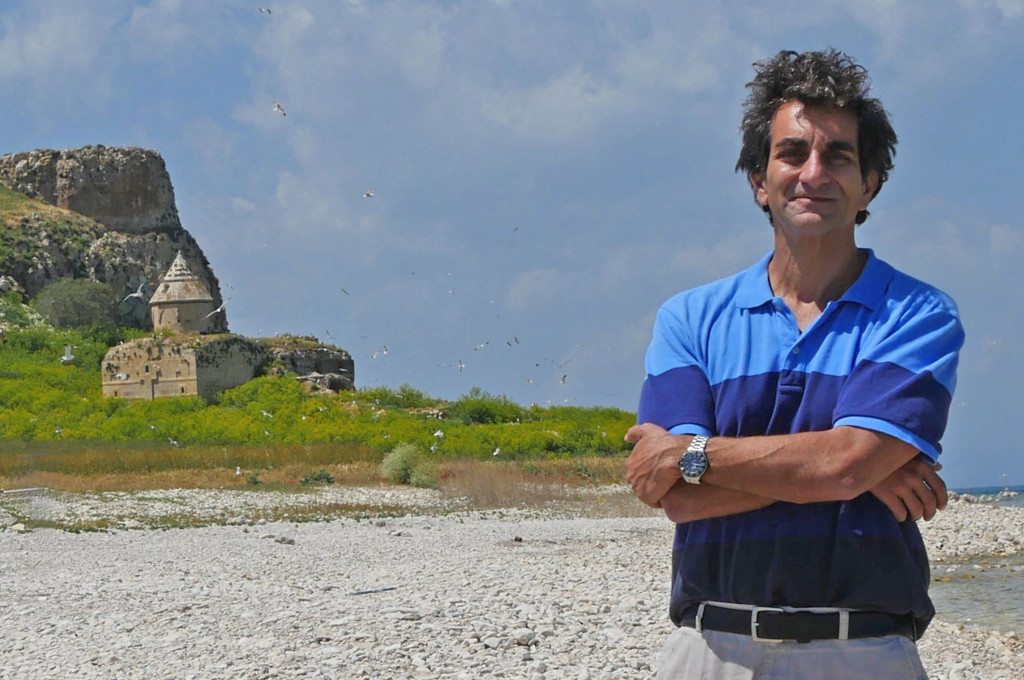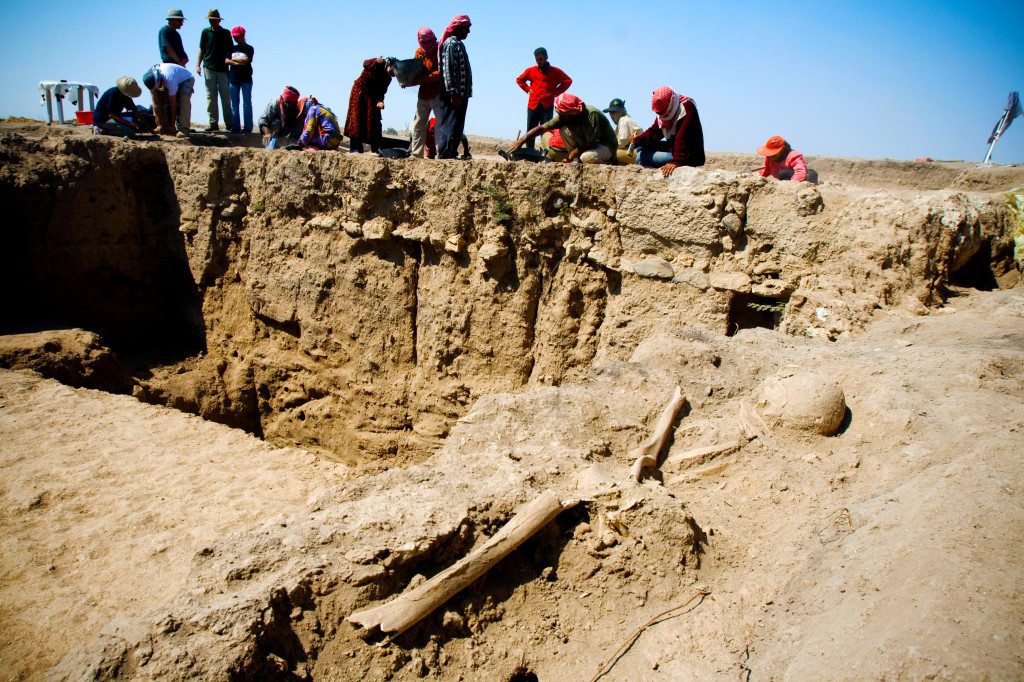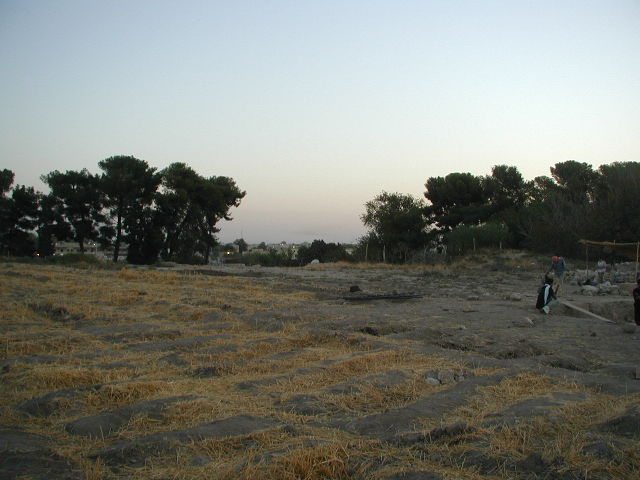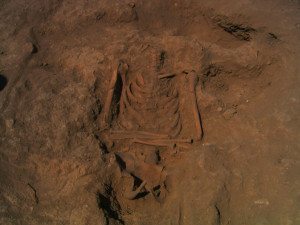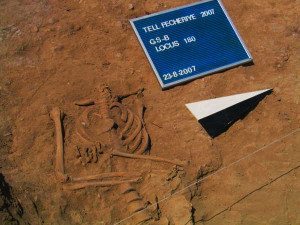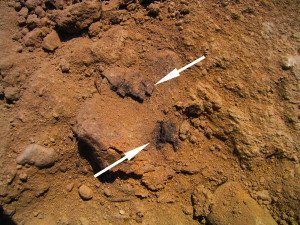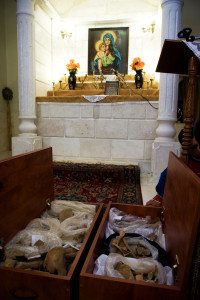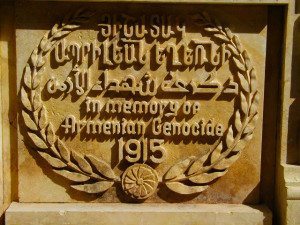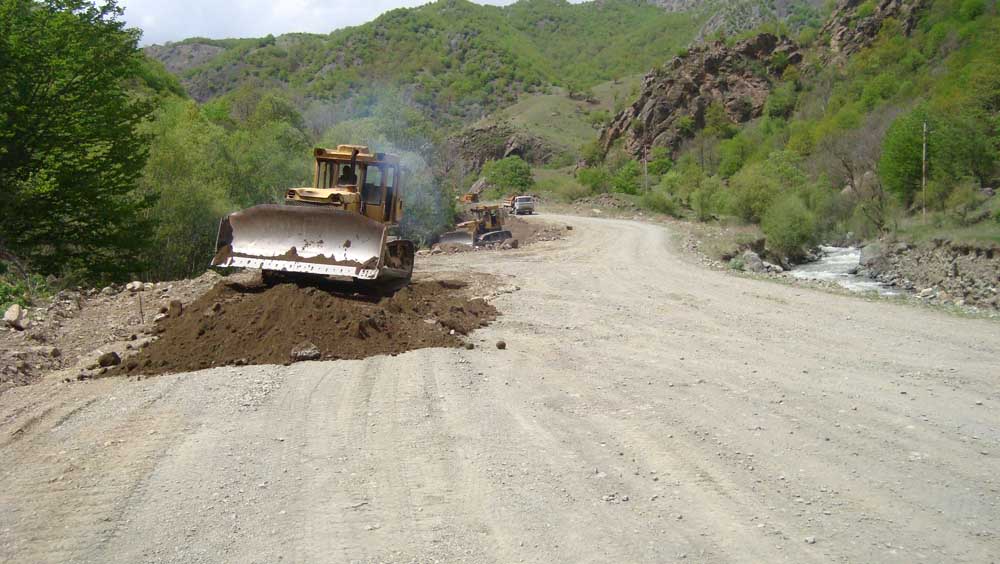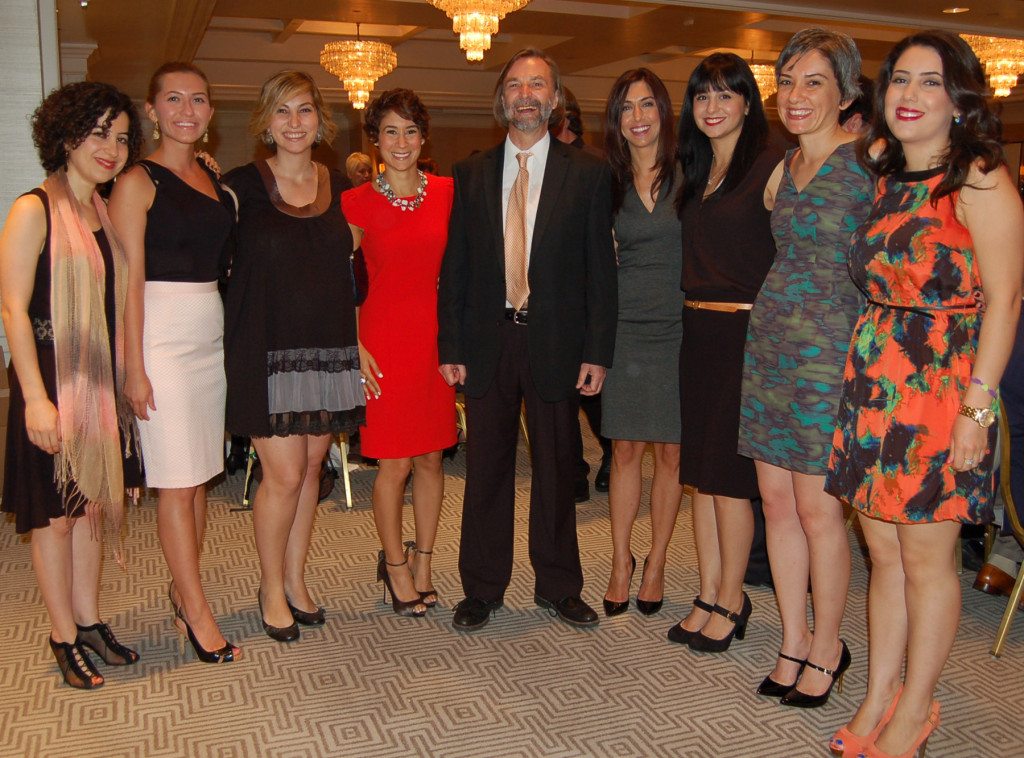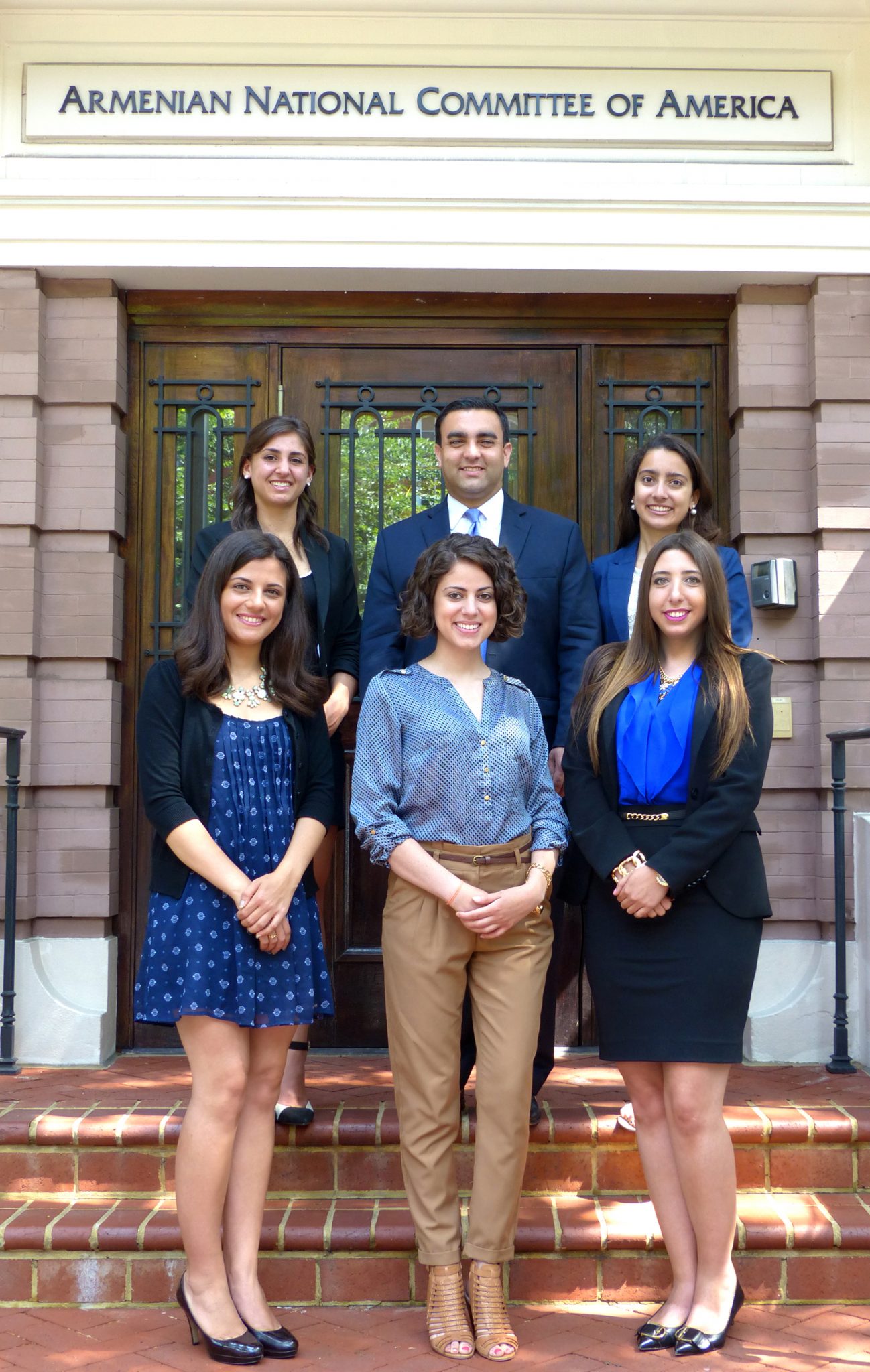By Roxana Ferllini and Alexandra M. Croft
The Armenian Weekly April 2014 magazine
The following article is aimed at both the Armenian community and the general reader, with the intention of highlighting work conducted whilst exhuming a mass grave at Tell Fakhariyah, Ras al-Ain, in Syria during the summer of 2007. Although two of the authors (Roxana Ferllini and Alexandra M. Croft) had previously published the work and results of the exhumations in a peer reviewed journal, the information, for the most part, has not made its way to a general readership outside of academia. Yet, this topic retains information of great importance, and needs to be made available to the wider public, which is why its publication is being made available through the Armenian Weekly.
The content of this article will summarize the events and results of the 2007 archaeological season, including the discovery of coins, textiles, and buttons associated with the human remains. The memorial ceremony and storage of the recovered remains at Ras al-Ain’s Armenian church is also highlighted. These exhumations represent the first, and perhaps, only, rescue of Ottoman-Armenian remains via the utilization of scientific methodology, through the application of archaeology and forensic anthropology.
However, further work in additional sites that are believed to contain human remains at Tell Fakhariyah has not been realized to date, due to time and budgetary constraints. The areas in question have also suffered damage for many decades from the farming activities and animal husbandry carried out by the Syrian Wakf (Islamic Trust).
It has been reported that the site at Tell Fakhariyah has not been damaged from the civil war that began to engulf Syria in 2011. However, the fate of the Armenian church in Ras al-Ain is not known. It is there that the exhumed remains are contained, due to shelling from the ongoing civil conflict. Other sites that contain the remains of Ottoman Armenians have not been properly exhumed; what exactly has happened in those areas in not known at present, due to the continually volatile situation in the area.
A further consequence of the civil violence in Syria is the fate of the Armenian population that has inhabited Ras al-Ain for many decades, and who were extremely helpful at the time of the excavations in various ways, including providing background information about the concentration camp created during the genocide. Changes have likely taken place with respect to the Armenian presence in Ras al-Ain, due to the exodus of the resident population of the region.
Photographs within the article illustrate not only the work that was completed on site, but the other areas within Syria that are of interest, due to their connection with the Armenian Genocide.
The article (2009, Journal of Human Rights, Volume 8, Issue 3, pp. 229-244) is reprinted by permission of Taylor & Francis LLC (www.tandfonline.com)
***
During the summer of 2007 at Ras al-Ain, in northeastern Syria, forensic archaeological exhumations took place at the archaeological site of Tell Fakhriya, involving a mass grave believed to hold the remains of Ottoman Armenians, who died at a nearby concentration camp after forced deportations by Ottoman officials. The objective of the forensic analysis of these remains was to obtain biological profiles of those buried within the grave. The exhumations conducted produced a minimum of 80 individuals in various states of skeletal preservation, including adults of both sexes and juveniles. The conclusions provided interesting results, some corroborating historical accounts, whilst also creating open questions. This work is believed to be the first conducted involving forensic archaeology and anthropology in connection to investigations of the Armenian Genocide.
Roxana Ferllini has worked in the fields of forensic archaeology and anthropology for the last 20 years. Her work has been conducted under a variety of circumstances, including consultancies for police forces in the United Kingdom and Costa Rica; she was also in charge of forensic anthropological work at a mass disaster incident in El Salvador. In the area of human rights, she has worked as part of investigations concerning mass killings in Rwanda, Kosovo, Syria, and Spain. During March 2008 her participation was requested in the role of an advisor during the discussion session “Search and Archaeological Exhumations of Human Remains in the Field and Cemeteries” held in Medellin, Colombia, entitled, “The Institutional Treatment of NNs in Colombia: Interdisciplinary Proposals from the Anthropological Point of View Regarding Non-identified Human Remains.” Most recently, she was invited to contribute suggestions pertaining to guidelines included within new legislation being prepared by the Spanish government dealing with mass grave investigations. She is currently the coordinator of the MSc in Forensic Archaeological Science at the University College London.
![Railway network and death camps at Ras al-Ain, Aleppo and Der Zor, the latter an important final destination point (modified from the Armenian National Institute www.armeniangenocide.org/map-southeast.html).]()
Railway network and death camps at Ras al-Ain, Aleppo and Der Zor, the latter an important final destination point (modified from the Armenian National Institute www.armeniangenocide.org/map-southeast.html).
Alexandra M. Croft is a graduate of the Institute of Archaeology, University College London, obtaining a B.A. (Hons) in archaeology in 2004, and a M.Sc. (Distinction) in forensic archaeological science in 2005. She has been excavating since 2001, on both urban and rural sites in the United Kingdom, Europe, and the Middle East. From 2006 to 2008, Alexandra worked for Pre-Construct Archaeology, London, United Kingdom. In 2005, she began working as an anthropologist and osteoarchaeologist, which led to her involvement in the Syrian excavation during the summer of 2007. In 2008 Alexandra worked with Kenyon International Emergency Services within mass disaster scenarios as a personal effects specialist. Her specific interests include skeletal trauma; in 2007 she published with her coauthor Roxana Ferllini, “Macroscopic Characteristics of Screwdriver Trauma” in the Journal of Forensic Sciences, volume 52, number 6.
The authors wish to give special thanks to Professor Dominik Bonatz of Freie Universitat Berlin and director of the archaeological project at Tell Fakhriya, Syria, who made this important work possible and also gave kind permission for its publication; to the Directorate of Antiquities and Museums in Damascus, Syria, especially the director of archaeology and excavations Dr. Michel Maqdissi; and to Terres et Cultures in France for their financial contribution. Thanks are also extended to all who participated in the excavation, in many varied roles. To Mr. M. Burza, photographer on site, and to Mr. S. Laidlaw photographer at the Institute of Archaeology, University College London for his input on illustrations prior to publication.
Introduction
The Ottoman Empire, once composed of multiethnic groups, began to collapse at the start of the 20th century due to internal and external forces that applied pressure to its power base. As a result of the shift in political climate, a nationalistic policy was set into motion, which emphasized one ethnic nation with a single language and an intolerant view of other minority groups, in the hopes of reunifying the empire. By 1915 this policy was set firmly into place with a strategy that included the objective of eliminating the Ottoman-Armenian population (Waller 2007), which was considered to be a threat to political stability. The displacement and persecution of the Armenian population commenced during 1915 under the shadow of World War I. Although pogroms had taken place against this population at the end of the 19th century, claiming a large number of victims, the change of political climate caused the nature of the killings to evolve into a systematic approach, and at a much grander scale (Weitz 2003). Massive deportations took place into regions such as northern Syria and Mesopotamia. The effects of coordinated large-scale massacres, willful exposure to the harsh desert environment, thirst, hunger, and disease combined to cause the majority of the deaths (Fisk 2006). Mass killings had lessened considerably by 1918; however, they subsequently resumed at a lesser scale and ended in 1923 with the fall of the Ottoman Empire (Hovannisian 1992; Winter 2003). Resultantly, hundreds of thousands of Ottoman Armenians perished in the process.
![Field work conducted at Tell Fakhriya, 2007. (Photograph by M. Burza)]()
Figure 2: Field work conducted at Tell Fakhriya, 2007. (Photograph by M. Burza)
In order for this systematic approach to succeed effectively, an organized system had to be put into place (Dadrian 1986), which included selecting deportation routes and the geographic placement of facilities for the purposes of detaining and processing the deportees. Of interest here is the zone of northern Syria, and specifically the town of Ras al-Ain, the latter being situated along the modern border with Turkey, where exhumations of human remains took place in the summer of 2007. According to the oral accounts of local inhabitants, the remains were those of Ottoman Armenians associated with a concentration camp that was located in the same area during the deportation process.
Ottoman Armenians at the start of the genocide
Prior to the Armenian Genocide, the Armenian population was distributed throughout different social strata within the Ottoman Empire. There was however, a clear divide between the class of urban Armenian merchants living in large towns and cities mainly outside of Armenia, and the majority that belonged to the peasant class (Bournoutian 1994; Sonyel 1987). Those living in urban areas worked within a wide range of occupations, including banking, trading, printing, and shop keeping, whilst those residing in villages were largely engaged in agricultural activities centered around the propagation of crops of millet, wheat, barley, and tobacco, and the herding of sheep and cattle (Balakian 2005; Hoogasian Villa 1982). Habitually, men were responsible for ploughing and were still utilizing traditional methods and tools at that time (Hoogasian Villa 1982; Haxthausen 1854). Women and children would assist with gathering the crops during the harvest (Lynch 1901; Ghazarian
1997). Food processing was labor intensive, including the grinding of grain and preparing bread, milking, and churning. Women and young boys were responsible for maintaining the household water supply (Hoogasian Villa 1982; Lynch 1901).
Other activities engaged in by the Armenian population included cottage industries such as shoemaking, and many were employed as blacksmiths, tinsmiths, furriers, stonemasons, and as carpenters (Arkun 2005; Bournoutian 1998; Ghazarian 1997; Hoogasian Villa 1982; Sonyel 1987; Davis 1879; Petrosyan and Marutyan 2001). Dependent on the size of the village, some of these jobs would not necessarily be full time; hence their work activities would often alternate and return to agriculture and animal husbandry for the balance of the time (Hoogasian Villa 1982). Additionally, craft activities were a very important part of daily life, both to produce items for potential trade and sale but also as a means of sustaining a largely self-sufficient way of life through cotton and carpet weaving, lace, and embroidery (Ghazarian 1997; Poghosyan 2001a; Haxthausen 1854; Poghosyan 2001b; Sharambeyan 2001).
On April 24, 1915, the way of life and the very existence of extended family units ended when an extermination process was formally put into place with the directed assassinations of all of the influential and intellectual Armenians in Constantinople, including journalists, educators, priests, and businessmen. The purposes of this action were twofold: to kill those who were perceived as a threat to the political structure but also to commence the destabilization of the Armenian population as a whole. Some were tortured and killed while in custody, while others were openly executed in public areas. This incident set into motion further calculated events that included the disarming of Armenian men serving in the Turkish army, who were then placed into forced labor. In villages and urban areas, men were taken from their homes and once outside they were summarily executed; the balance of women, children, and older individuals were forcefully deported in what is often referred to as death marches or transported in cramped rail wagons. Meanwhile, their properties were looted, seized, or burnt, with the vast majority of individuals being expelled into the desert areas of northern Syria, Iraq, and beyond (Weitz 2003; Fisk 2006; Toynbee 1915; BBC 2003; Dadrian 1986; Slide 1997).
Death marches and Ras al-Ain
The majority of those who perished during the deportations died along forced marching routes, where it was customary for the dead to be abandoned and left unburied where they fell (Abbamontian 2007; BBC 2003; Dadrian 1986). The exact number of those who died is not known with certainty; however, it is estimated that approximately one million perished, a figure accounting for some 48 percent of the estimated total Armenian population at the time (Weitz 2003; Waller 2007).
Several methods were utilized to kill those being deported, yet it must be kept in mind that the physical environment into which these individuals were being forced was not only harsh but also one to which they were totally unaccustomed (Toynbee 1915). The combination of starvation and the lack of access to water were the main means used to kill the deportees; however, other methods included the killing of children through blunt force trauma, and with weapons such as bayonets; many were thrown into rivers by their own mothers before they were able to be killed. Pregnant women and old men were whipped and beaten during the marches (Arissian 2007; BBC 2003). Some families were bound up and thrown into rivers, or simply allowed to drown, with the Euphrates River being one of the most heavily used for this purpose (Fisk 2006; Weitz 2003). Others were burnt alive, beheaded, and mutilated by the means of a variety of weapons such as knives, swords, bayonets, clubs, and stones.
Many suffocated in caves, whilst dead bodies were placed into wells to contaminate potential water sources. Torture was openly practiced, in addition to the crucifixion of young women; gang rape and forced submission to sexual acts in order to procure food, water, and protection for other members of the group was also reported. Money had been confiscated, thereby leaving individuals unable to buy privileges, and often without any manner of clothing. Once dead, everything considered of value was taken from the bodies (Fisk 2006; Slide 1997; Waller 2007; Weitz 2003; Mugerditchian 1918; Kevorkian 1998a; Daily Mail 2007). These acts were reasonably straightforward to achieve as the environment in which they were conducted offered a propitious opportunity to commit the said killings en-masse (Dadrian 2003; K´evorkian 1998b).
Those who had survived the long journey south were gathered in concentration camps that were set up at prescribed points. It is reported that over 20 of these camps existed during these deportations; the majority located within what today comprises the northern borders of Syria and Iraq, an area known for its harsh and unforgiving desert environment. Such a camp was located at Ras al-Ain, and others further south, for example at Der Zor, which was a main and final destination point (Figure 1). The conditions in the camps were extremely dire, with diseases such as dysentery and typhus being rife (Daily Mail 2007; Armenian National Institute 2008; Arissian 2007; Nichanian 2007).
Accounts outlining the critical nature of the situation were conveyed by survivors, missionaries, foreign railway workers and foreign officials from the United States of America and the United Kingdom. In Syria, in the areas between Ras al-Ain and Aleppo, the arrival was reported of children, adults, and the elderly suffering from starvation, lack of clothing, and disease (Arissian 2007; Dadrian 1986; Daily Mail 2007). Despite this, photographic testimonies are few, as in the early part of 1916 the Turkish authorities forbade the recording of the events by camera (Armenian National Institute 2008).
Originally, Ras al-Ain had been a rather small village, situated north of the River Habur; however, the village grew and gained importance when the railway was constructed. The area was inhabited in the early part of the 20th century by groups of different ethnic backgrounds, who were either sedentary or nomadic. Some of these groups participated (as also happened in other areas along the deportation routes) in aiding the Ottoman Empire commit human rights abuses at different levels. Because of its geographical location and connection to the railway network (Figure 1), Ras al-Ain became an ideal arrival point, administrative center, and location to form a concentration camp (Armenian National Institute 2008; Kevorkian 1998b). The arrivals of Ottoman Armenians occurred by foot and by train, in extremely cramped wagons that held between 60 and 85 individuals indisposed to any means of personal hygiene. The majority emanated mainly from the western zone of Turkey (Yernon 2002; Kevorkian 1998a, 1998b, 1998c).
Once the concentration camp at Ras al-Ain was in place, torture, rape, massacres, and further deportations took place on a large scale (Fisk 2006; Kevorkian 1998b). There are various statements pertaining to the number of deportees arriving at Ras al-Ain; for 1915 it was reported at 4,500 (Toynbee 1915). At the beginning of February 1916, the number was estimated at 20,000, and by mid-February the estimate rose to 50,000 (Armenian National Institute 2008).
Survivors and those who witnessed the local conditions indicated that the camp was just outside the village, set upon a hill with thousands of makeshift tents, some of which barely provided sufficient cover from the scorching sun or the coldness of winter. Life was harsh, and often with the most basic of necessities, with the perpetual fear of physical aggression and of looters stealing the few remaining possessions the individuals may have managed to retain. Deportees died daily for a variety of reasons with some of the bodies remaining within the tents. Individuals who had managed to retain some material possessions used their funds in order to live in somewhat better conditions and to buy protection (Kevorkian 1998a, 1998d; Yernon 2002).
The large-scale killings took place in two waves, divided into those who died before November 1915 and those who perished between March and November of 1916; in the latter case, orders had arrived directly from Constantinople as the administration wanted the deportees to be eliminated (Yernon 2002; Kevorkian 1998b). According to the Armenian National Institute (2008) by mid April of 1916, the massacres in Ras al-Ain had taken the toll of 70,000 victims.
One survivor stated that at the beginning of March 1916, deportees were ordered to move on and to leave whatever they had behind; many were killed through the effects of beatings if they did not move quickly enough. These convoys were composed of groups, as the deportees were not sent out en-masse. Whilst on the road demands were still being made for money, with some victims having their stomachs slashed in order to search for coins (Kevorkian 1998d). Others were drowned in various rivers including the River Habur; after the genocide, skeletonized remains were reported along the bank of this river; although it has changed its course over time (Fisk 2006; Nichanian 2007).
During the respite from mass killings between December 1915 and March 1916 it is pointed out that between 13,000 to 14,000 Armenians continued to die. This occurred as a result of starvation, as many tried to subsist on the garbage they could find, and also from diseases, which turned any otherwise minor illness into a serious condition. Typhus was endemic among the deportees, with no medical attention being provided in order to eliminate further propagations. During that period, deportees who could provide a trade became involved in market activities such as crafts, providing for a few the means of shaping their lives somewhat for the better, and to enable the purchase of temporary protection (Yernon 2002; Kevorkian 1998c).
The above information is valuable in order to draw up a background upon which the events at Ras al-Ain took place; yet, it must be kept in mind that these sources do not necessarily spring from careful conducted censuses, but from estimated figures. What these sources do clearly illustrate pertains to the episodes of killing en masse, the modes utilized, and the living conditions within the camps.
Exhumations at Tell Fakhriya, Ras al-Ain
In the summer of 2006 archaeological excavations were conducted at the site of Tell Fakhriya (meaning “pottery sherd mound”), located to the south of Ras al-Ain and at the source of the River Habur (Tell Fecheriye 2008). During the field work, archaeologists under the direction of Prof. D. Bonatz, from Freie Universitat Berlin, unearthed several human remains close to the surface. These were believed to be part of an Armenian mass grave due to the excavation of coins found in context and also on oral accounts from the local Syrian-Armenian community, who indicated it to be a mass grave containing remains from the Armenian Genocide. Additionally, the locals pointed out the existence of a concentration camp nearby during the time when the deportations were in active progress. The authors became involved with the same group of archaeologists during the field season of 2007 (Figure 2) and carried out forensic exhumations, and the biological profiling (sex, age, stature, and individual traits) of the victims where possible; moreover, it was deemed important to determine the presence of and possible causes of trauma.
Although witnesses reported seeing bodies in various states of decomposition during the time that the events were actually taking place, and more recent generations of visiting Armenians reported the presence of skeletal remains (Fisk 2006; Weitz 2003), it is believed that this was the first intervention in which victims of the Armenian Genocide have been exhumed and properly documented using a forensic archaeological and anthropological approach.
When the forensic work commenced in the field, the area had suffered severe alteration due to many factors taking place over several decades, these being mainly the effects of agricultural and human intervention (Figure 3), causing the human remains present to become commingled, incomplete, and in some cases fragmented. Additionally, the effects of weathering caused variation in bone preservation, but the great majority of remains were in good enough condition to handle and analyze. The majority, 84 percent, were found in clusters, that is, bodies found in groups ranging in number from two individuals to seven. There was no continuum as expected for a mass grave; this was believed to have been a partial consequence of the area being utilized by the local population for many years, with many of the remains being lost, made incomplete or damaged in the process.
![Figure 3: Agricultural area showing tilling next to archaeological site.]()
Figure 3: Agricultural area showing tilling next to archaeological site.
The above circumstances altered their original positions and contexts of the human remains, both within the grave site and the relationship of the individuals to each other. However, there were two striking exceptions to this: during the exhumations two adults, an adult male and female, were found in situ as they had been put to rest at the time of burial. They were not next to each other, consequently they were not buried in relation to one another; however their resting position was the same, that is, supine with both arms flexed at the elbow and forearms crossed over the abdominal area (Figure 4). The fact that these two bodies were in such positions indicates care during burial.
References to burial practices at the camp at Ras al-Ain were not obtainable; yet, there are accounts from other regions, which indicate that among the refugees there were individuals who would act as gravediggers; few had the means to have their loved ones buried by deported priests in single graves (K´evorkian 1998c, 1998e, 1998f). If one can imagine similar situations at the camp in Ras al-Ain, the discovery of these two individuals would seem to substantiate statements from local oral accounts that the grave in Ras al-Ain was used to deposit the victims as they died, perhaps some from disease, starvation, or from single violent attacks, rather than being a mass grave utilized to dispose of the bodies in haste after mass killings as witnessed in places such as Rwanda.
![Figure 4a: Male with arms crossed over abdominal area.]()
Figure 4a: Male with arms crossed over abdominal area.
Additionally, there were few personal belongings or material goods recovered during the exhumations of 2007, except for several buttons, a small amount of textiles, a semicircular metal type material, a finger ring, and a few coins. Based on respective experiences with other mass graves related to human rights abuses, and on archaeological burial and disposal sites of varying types, the authors would have generally expected to find more personal artifacts, particularly those indicating the presence of clothing at the time of deposition, despite disturbance. The lack of personal objects on this site appears to reinforce the evidence that suggests that deportees were quite literally stripped of any items of value on the journey to or at the concentration camp itself. The limited remains that are suggestive of the presence of clothing (buttons) would appear to indicate that the majority of individuals were buried naked. However, an interesting exception to these findings was the female discovered in situ, undisturbed and exhumed with a metal finger ring, degraded fabric pieces (Figure 4b and Figure 5) with a metal stud, one button, and a coin. This female was buried with money, jewelry, and potential clothing, elements that were respected by those that buried her (despite the benefits that such objects could have bought for others in the camp or for someone who may have chosen to remove them from her). Such findings appear to further substantiate the accounts of those with means receiving special funerary treatment.
![Figure 4b: Female with arms crossed over abdominal area.]()
Figure 4b: Female with arms crossed over abdominal area.
Once the remains were exhumed, they were packed and transported for analysis.
Laboratory work
The laboratory work was conducted in Ras al-Ain, in a physical space provided for this purpose utilizing basic anthropological equipment including an osteometric board for stature estimation, callipers, and consulting literature. The authors analyzed the remains exhumed from 2006 and 2007; although they were not involved in the exhumations conducted during the prior year.
Because the majority of the remains were found commingled and incomplete, each associated cluster of commingled skeletal remains was inventoried carefully, taking into consideration duplicate skeletal elements and corresponding features, in order to arrive at a minimum number of individuals (MNI). Once the number of individuals were identified, the biological profile of each was determined, which in some cases was partial as they were represented by one or a very few bones.
The osteological analysis resulted in a minimum of 80 separate individuals recognized from 31 loci (26 of these worked by the authors in 2007). The breakdown by age for those exhumed in 2006 resulted in a minimum of 26 individuals, 13 adults and 13 juveniles from five loci (the term juvenile is used here to refer to young individuals as opposed to adults). From the 2007 exhumations, a minimum of 54 individuals were recognized, comprised of 29 adults, 18 juveniles (including 3 infants), and a possible fetus. Five individuals were too badly degraded to provide enough skeletal information to ascertain adult or juvenile status with certainty, and one individual was borderline juvenile/adult (estimated at being above 14-19 years of age). Of the overall total, only 20 percent of individuals presented sufficient morphological traits to attempt to determine the sex; the final breakdown came to three males, three possible males, one intermediate, eight females, and one possible female. The higher representation of females and juveniles seems to be in accordance to the population composition sent on the death marches.
![Remnants of black textile found on the female’s chest. The color might not be the original one as modifications in tones may occur through time (also see Figure 4b).]()
Remnants of black textile found on the female’s chest. The color might not be the original one as modifications in tones may occur through time (also see Figure 4b).
Positive identifications were impossible to conduct as there was no manner of establishing the identities of those buried at Ras al-Ain, and consequently no prospect of tracing possible living relatives.
Three aspects to note pertaining to the remains analyzed are the overall lack of paleopathological conditions, the lack of verifiable perimortem trauma, and the low number of cranial and dental remains recovered. In the first instance, this may be due to the incompleteness of the remains (Waldron 1987). Three separate individuals exhibited paleopathologies; one lumbar vertebra exhibited a Schmorl’s node (a defect created by a herniated vertebral disc) (Aufderheide and Rodriguez-Martin 2003); and one second cervical vertebra exhibited morphological distortion, with the causation not identified. Finally, a set of associated ribs presented marginal growth on the inferior border, perhaps part of a set of indicators for a particular condition, but not identified. No antemortem fractures were noted. In relation to perimortem trauma there was only one example, a wound to a rib on the ventral side possibly caused by a sharp instrument; the rib could not be associated with a particular individual and was recovered during the 2006 field work. This find lead the authors to believe that the remains for the most part belonged to Armenians who lost their lives through starvation, thirst, and disease and not through violent deaths; yet it is necessary to point out that the remains were incomplete and probably missing the bones that may have displayed evidence of perimortem trauma.
Analysis of the remains also highlighted that there was a noticeable lack of cranial and dental elements; rather puzzling, as they were only found in 33 percent of the total loci worked on. Despite the levels of commingling and degradation of the skeletal remains, the authors would have expected to have recovered a higher level of dental and cranial elements as a pattern of high-preservation levels of these features has been previously noted (Stojanowski et al. 2002). In addition, past archaeological experience has illustrated to both authors that even if skulls have become fragmented and have been disturbed since deposition, certain robust portions of the skull have a high survival rate and will therefore represent the presence of that particular skull during anthropological analysis. These generally include the petrous portions of the skull (protective structure for the inner ear), which preserve rather well due to their sturdy composition (Waldron 1987). In addition, teeth are also an extremely durable element of the human skeleton and have a high frequency in the archaeological record; on a site where skeletonized remains have been disturbed, a scatter of teeth is often apparent.
![Ceremony held at the Armenian Church in Ras al-Ain. (Photograph by M. Burza)]()
Ceremony held at the Armenian Church in Ras al-Ain. (Photograph by M. Burza)
On this particular site, the only skull portions discovered were fragmented, and with a minimum of 42 adult inhumations, it may have been expected that many teeth were to be recovered, even if they could not be assigned to said individuals. There were however, few teeth found, and many of the loci contained none. In contrast to the low frequency of these robust dental and cranial elements, other bones, which typically have a low representation in the archaeological record, due to their small size and light structure, such as the scapula (Waldron 1987; Stojawoski et al. 2002), were present. Both adult and the more fragile juvenile scapulae were recovered and were often in better condition than the small number of dental and cranial remains present, illustrating that the skeletal structures preserved at Tell Fakhriya in part do not reflect the usual patterns reported in the literature. The unique taphonomic features of a site are vital to consider when studying assemblages in terms of making an assessment of differing types and levels of preservation, and whilst agricultural activities may account for most of the alterations at the site, it does not fully explain the inconsistencies as to what would normally be expected from the bodies exhumed.
Effecting closure
Rituals are important events within any given social group; however, the characterization of each ritual varies depending on the cultural context in which it occurs (Handelman and Lindquist 2005) as they are acknowledged according to cultural practices. Yet death is an event that is recognized by all societies, and mortuary rites in most cultures assist in providing closure and acceptance, thereby aiding the grieving process. Within the context of the past century to the present day, there have been major events such as natural disasters, wars, terrorist acts, and human rights abuses that have brought about the deaths of millions of people, along with destruction to their established ways of life and social ties with members of their communities. Resultantly, such circumstances may not provide the opportunities for burials, and to grieve for the dead as prescribed culturally (Katz 2001). In the case of the Armenian genocide, the burials of the victims were not a matter of large scale or individual choice, and the majority of those who survived, or who follow in successive generations, are unaware with any certainty as to where their loved ones lie.
In September 2007, the remains exhumed at Tell Fakhriya were taken to the local Armenian Church for a proper funerary ceremony (Figure 6). Here, for reasons already stated, there was no individual identification of the bodies; therefore it might not be considered as a rite of separation (Huntington and Metcalf 1979), as no close kin was possible.
![Plaque commemorating the Armenian Genocide in Aleppo, Syria.]()
Plaque commemorating the Armenian Genocide in Aleppo, Syria.
Yet, the Syrian-Armenian community expressed appreciation for the work conducted, and also a deep feeling of relief on behalf of the victims as they were finally receiving a proper ceremony and place of rest.
Although 93 years have lapsed since the commencement of the Armenian Genocide, Armenian communities have collectively carried forth the memories of those lost by keeping the events that took place alive in the public mind. This has been accomplished by erecting monuments and plaques (Figure 7) and by holding an annual day of remembrance on April 24th (Weitz 2003; Fisk 2006). This day of commemoration is held and appreciated globally by Armenian communities, serving to ease their sense of loss and frustration, with the events of the past still marking their lives in every respect in the present (BBC 2003).
Conclusion
The forensic work conducted at Tell Fakhriya produced interesting results. Historical records, mirrored with recollections from the local Syrian-Armenian community at Ras al-Ain, appear to corroborate some of the authors’ findings at the mass grave site. These results appear to positively confirm the presence of a camp and a nearby mass grave located upon a hill on the outskirts of Ras al-Ain, Syria.
Furthermore, the exhumation of two individuals that were carefully buried, with one individual retaining items of value, reinforces the assertion that those of means were able to afford the luxury of burying their loved ones with dignity.
Conversely, the relative lack of cranial and dental remains in generally anticipated quantities presented an interesting departure from what has been previously observed by the authors. Additionally, bones, which according to the literature should be less inclined to good preservation, were recovered in better condition than would have been expected.
This paradox cannot be readily explained. Although the area has been actively utilized for human activities over several decades, such as agriculture, this does not present an adequate explanation for the inverse presence of certain recovered remains.
In addition, archaeological excavations were conducted at Tell Fakhriya in 1940 under the direction of C. McEwan from the Oriental Institute, University of Chicago (McEwan et al. 1958). In 1955, a short excavation was undertaken by A. Moortgat (Max Oppenheim Foundation) and another by Abd al-Masih Bagdo (Department of Antiquities and Museums of Hasseke) and A. Pruss (University of Halle) during 2001. However, the areas worked on in prior activities in the area did not encompass the site upon which the authors conducted their work (D. Bonatz, pers. comm.). Therefore, the relative lack or surplus of certain remains cannot be readily explained as a result of prior disturbance due to archaeological activity, thereby presenting an interesting open question that may never be satisfactorily resolved.
Sources
Abbamontian, Ramela. (2007) The diasporic witness: reconstruction of testimony by contemporary Los Angeles artists. In The Armenian Genocide: Cultural and Ethical Legacies, Richard Hovannisian (ed.) (New Brunswick: Transaction Publishers), pp. 177-211.
Arissian, Nora. (2007) The Armenian genocide in the Syrian press. In The Armenian Genocide: Cultural and Ethical Legacies, Richard Hovannisian (ed.) (New Brunswick: Transaction Publishers), pp. 303-307.
Arkun, Aram. (2005) Into the modern age, 1800–1913. In The Armenians, Edmund Herzig and Marina Kurkchiyan (eds.) (London: Routledge-Curzon), pp. 68-81.
Armenian National Institute. (2008) [Online]. Available: http://www.armeniangenocide.org/chronology.html [Sept. 29, 2008].
Aufderheide, Arthur, and Rodriguez-Martin, Conrado. (2003) The Cambridge Encyclopedia of Human Paleopathology (Cambridge: Cambridge University Press).
Balakian, Peter. (2005) The Burning Tigris: A History of the Armenian Genocide (London: Pimlico).
BBC. (2003) Armenia: The Betrayed. [Online]. Available: http://video.google.com/videoplay?docid=-7833166317264817428 [Oct. 27, 2008].
Bournoutian, George. (1994) The History of the Armenian People. Volume II: 1500 AD to the Present (Costa Mesa: Mazda Publishers).
Bournoutian, George. (1998) Russia and the Armenians of Transcaucasia, 1797–1889 (Costa Mesa: Mazda Publishers).
Dadrian, Vahakn. (1986) The Naim-Andonian Documents in the World War I Destruction of the Ottoman Armenians: The Anatomy of a Genocide. International Journal of Middle East Studies, 18(3), 311-360.
Dadrian, Vahakn. (2003) Patterns of Twentieth Century Genocide: The Armenian, Jewish, and Rwandan Cases. Journal of Genocide Research, 6(4), 487-522.
Daily Mail. (2007) The Forgotten Holocaust: The Armenian Massacre that Inspired Hitler.
[Online]. Available: http://www.dailymail.co.uk/news/article-479143/The-forgotten-Holocaust-The-Armenian-massacre-inspired-Hitler.html [Oct. 27, 2008].
Davis, Edwin. (1879) Life in Asiatic Turkey (London: Edward Stanford).
Fisk, Robert. (2006) The Great War for Civilisation: The Conquest of the Middle East (London: Harper Perennial).
Ghazarian, Vatche. (1997) A Village Remembered. The Armenians of Habousi (Monterrey: Mayreni Publishing).
Handelman, Don, and Lindquist, Galina (eds.). (2005) Ritual in its Own Right: Exploring the Dynamics of Transformation (Oxford: Berghahn Books).
Haxthausen, August Von. (1854) Transcaucasia (London: Chapman and Hall).
Hoogasian Villa, Susie. (1982) Armenian Village Life Before 1914 (Detroit: Wayne State University Press).
Hovannisian, Richard (ed.). (1992) The Armenian Genocide: History, Politics, Ethics (London: Macmillan Academic and Professional LTD).
Huntington, Richard, and Metcalf, Peter. (1979) Celebrations of Death: The Anthropology of Mortuary Ritual (Cambridge: Cambridge University Press).
Katz, Jeanne. (2001) Conclusion. In Grief, Mourning and Death Ritual, Jenny Hockey et al. (eds.) (Buckingham: Open University Press), pp. 267-273.
Kevorkian, Raymond. (1998a) Revue d’histoire Armenienne contemporaine tome II. L’extermination des d´eportes Armeniens ottomans dans les camps de concentration de Syrie-Mesopotamie (1915-1916), 26 – Ras ul-Aın. [Online]. Available: http://www.imprescriptible.fr/rhac/tome2/p2t26 [Oct. 30, 2008].
Kevorkian, Raymond. (1998b) Revue d’histoire Armenienne contemporaine tome II.
L’extermination des deportes Armeniens ottomans dans les camps de concentration de Syrie-
Mesopotamie (1915-1916), 22- Les massacres de Ras ul-Aın. [Online]. Available: http://www.
imprescriptible.fr/rhac/tome2/p2t22 [Nov. 3, 2008].
Kevorkian, Raymond. (1998c) Revue d’histoire Armenienne contemporaine tome II. L’extermination des d´eport´es Armeniens ottomans dans les camps de concentration de Syrie-Mesopotamie (1915-1916), 23 – La situation des Armeniens deportes a Ras ul-Aın et leur extermination. [Online]. Available: http://www.imprescriptible.fr/rhac/tome2/p2t23 [Nov. 3, 2008].
Kevorkian, Raymond. (1998d) Revue d’histoire Armenienne contemporaine tome II. L’extermination des deportes Armeniens ottomans dans les camps de concentration de Syrie-Mesopotamie (1915-1916), 25 – Scenes de la vie de s deportes de Ras ul-Aın. [Online]. Available: http://www.imprescriptible.fr/rhac/tome2/p2t25 [Nov. 3, 2008].
Kevorkian, Raymond. (1998e) Revue d’histoire Armenienne contemporaine tome II. L’extermination des d´eport´es Arm´eniens ottomans dans les camps de concentration de Syrie-Mesopotamie (1915-1916), 11- La situation a Bab lors du depart du dernier convoi de 1916. [Online]. Available: http://www.imprescriptible.fr/rhac/tome2/p2t11 [Nov. 3, 2008].
Kevorkian, Raymond. (1998f) Revue d’histoire Armenienne contemporaine tome II. L’extermination des deportes Armeniens ottomans dans les camps de concentration de Syrie-Mesopotamie (1915-1916), 6 – L’univers des camps de concentration. [Online]. Available: http://www.imprescriptible.fr/rhac/tome2/p1f [Nov. 3, 2008].
Lynch, Harry Finnis Blosse. (1901) Armenia Travels and Studies, Volume One (London: Longmans, Green & Co.).
Mcewan, Calvin, et al. (1958) Soundings at Tell Fakhariyah (Chicago: The University of Chicago Press).
Mugerditchian, Esther. (1918) From Turkish Toils: The Narrative of an Armenian Family’s Escape (London: C. Arthur Pearson Ltd.).
Nichanian, Marc. (2007) Testimony: From document to monument. In The Armenian Genocide:
Cultural and Ethical Legacies, Richard Hovannisian (ed.) (New Brunswick: Transaction Publishers), pp. 41-62.
Petrosyan, Hamlet, and Marutyan, Harutyun. (2001) 4.3-Copper. In Armenian Folk Arts, Culture and Identity, Levon Abranamian and Nancy Sweezy (eds.) (Indianapolis: Indiana University Press), pp. 137-149.
Poghosyan, Ashghunj. (2001a) 4.4-Carpets. In Armenian Folk Arts, Culture and Identity, Levon Abranamian and Nancy Sweezy (eds.) (Indianapolis: Indiana University Press), pp. 150-164.
Poghosyan, Ashghunj. (2001b) 5.1-Costume. In Armenian Folk Arts, Culture and Identity, Levon Abranamian and Nancy Sweezy (eds.) (Indianapolis: Indiana University Press), pp. 177-193.
Sharambeyan, Anush. (2001) 4.5-Needle Arts. In Armenian Folk Arts, Culture and Identity, Levon Abranamian and Nancy Sweezy (eds.) (Indiana University Press), pp. 165-174.
Slide, Anthony (ed.). (1997) Ravished Armenia and the Story of Aurora Mardiganian (London: The Scarecrow Press, Inc.).
Sonyel, Salahi. (1987) The Ottoman Armenians (London: K. Rustern & Brother).
Stojanowski, Christopher, et al. (2002). Differential Skeletal Preservation at Windover Pond: Causes and Consequences. American Journal of Physical Anthropology, 119(1), 15-20.
Tell Fecheriye. (2008) [Online]. Available: http://www.fecheriye.de/index.php?lang=eng [Oct. 7, 2008].
Toynbee, Arnold. (1915) Armenian Atrocities: The Murder of a Nation (London: Hodder & Stoughton).
Waldron, Tony. (1987) The relative survival of the human skeleton: implications for paleopathology.
In Death, Decay and Reconstruction: Approaches to Archaeology and Forensic Science, Andrew Boddington et al. (eds.) (Manchester: Manchester University Press), pp. 55-64.
Waller, James. (2007) Becoming Evil: How Ordinary People Commit Genocide and Mass Killing, 2nd edition (Oxford: Oxford University Press).
Weitz, Eric. (2003) A Century of Genocide: Utopias of Race and Nation (Princeton: Princeton University Press).
Winter, Jay. (2003) Under the Cover of War: The Armenian Genocide in the Context of Total War. In The Specter of Genocide: Mass Murder in Historical Perspective, Robert Gellately and Ben Kierman (eds.) (Cambridge: Cambridge University Press), pp. 189-213.
Yernon, Yves. (2002) Revue d’Histoire Armenienne Contemporaine tome IV. Anatomie pathologique d’une destruction, cinquieme partie – Naufrages et rescapes Alep, Ras ul-Aın, Mossoul, le Sindjar. [Online]. Available: http://www.imprescriptible.fr/rhac/tome4/l1-p5-ch5 [Oct. 30, 2008].
The post Ferllini and Croft: The Case of an Armenian Mass Grave appeared first on Armenian Weekly.


